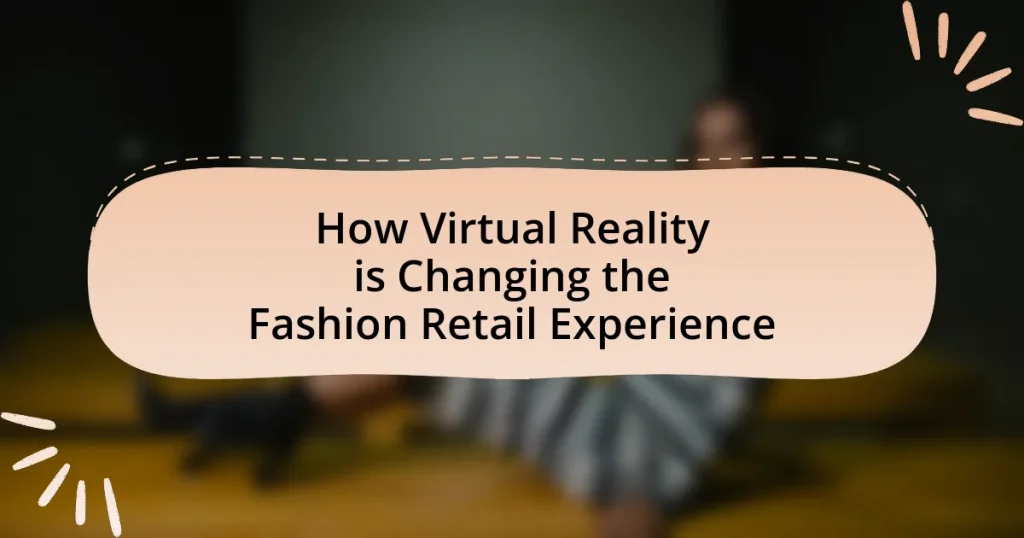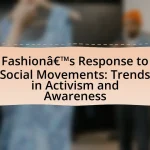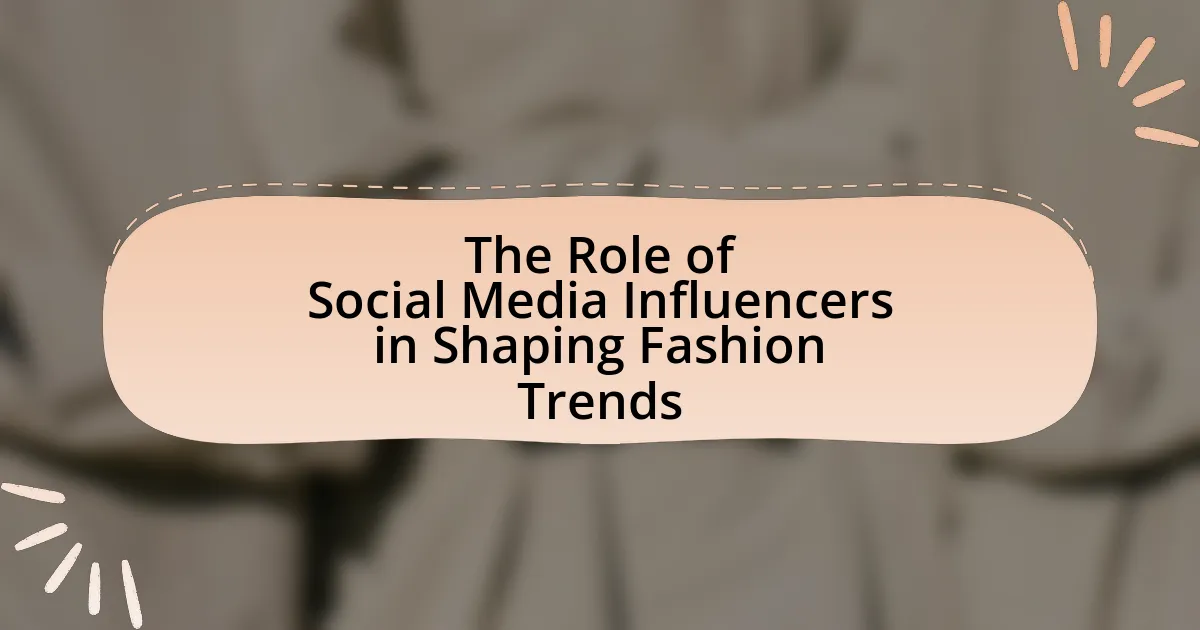Virtual Reality (VR) is significantly transforming the fashion retail experience by creating immersive shopping environments that enhance customer engagement and decision-making. Key features of VR in fashion retail include virtual try-ons, interactive product exploration, and personalized recommendations, which collectively improve customer satisfaction and reduce return rates. Retailers like Tommy Hilfiger and Gucci have successfully implemented VR technology, leading to increased brand loyalty and sales. However, challenges such as high implementation costs and technical limitations remain. The article explores the impact of VR on consumer behavior, purchasing decisions, and future trends in the fashion retail sector, providing insights into how retailers can effectively integrate this technology into their strategies.
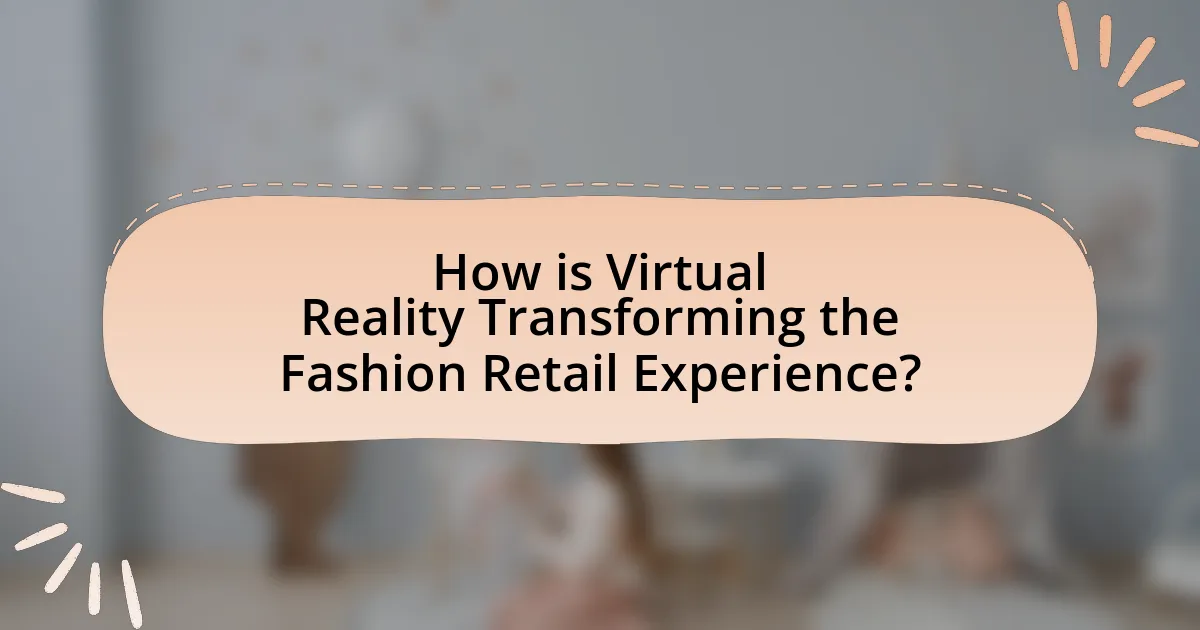
How is Virtual Reality Transforming the Fashion Retail Experience?
Virtual Reality (VR) is transforming the fashion retail experience by enabling immersive shopping environments that enhance customer engagement and decision-making. Retailers are utilizing VR technology to create virtual showrooms where customers can explore products in a 3D space, allowing them to visualize how clothing fits and looks without physically trying it on. For instance, brands like Tommy Hilfiger and Gucci have implemented VR experiences that allow users to walk through virtual stores and interact with products, leading to increased customer satisfaction and reduced return rates. According to a study by the National Retail Federation, 61% of consumers prefer shopping in stores that offer VR experiences, highlighting the effectiveness of this technology in attracting and retaining customers.
What are the key features of Virtual Reality in fashion retail?
The key features of Virtual Reality in fashion retail include immersive shopping experiences, virtual try-ons, and enhanced customer engagement. Immersive shopping experiences allow customers to explore virtual stores as if they were physically present, providing a unique and interactive environment. Virtual try-ons enable customers to visualize how clothing and accessories will look on them without needing to physically wear the items, significantly reducing return rates. Enhanced customer engagement is achieved through interactive elements, such as personalized recommendations and social sharing options, which foster a deeper connection between brands and consumers. These features collectively transform the shopping experience, making it more engaging and efficient for customers.
How does Virtual Reality enhance customer engagement in fashion retail?
Virtual Reality enhances customer engagement in fashion retail by providing immersive experiences that allow customers to interact with products in a virtual environment. This technology enables shoppers to visualize clothing and accessories on themselves through virtual try-ons, which increases their confidence in purchasing decisions. According to a study by the International Journal of Retail & Distribution Management, 61% of consumers reported a higher likelihood of purchasing after using virtual fitting rooms. Additionally, VR experiences can create emotional connections by allowing customers to explore virtual stores or attend fashion shows, thereby increasing brand loyalty and customer satisfaction.
What technologies are used to implement Virtual Reality in fashion retail?
Virtual Reality in fashion retail is implemented using technologies such as head-mounted displays (HMDs), augmented reality (AR) applications, 3D modeling software, and motion tracking systems. HMDs, like the Oculus Rift and HTC Vive, provide immersive experiences by allowing users to visualize clothing in a virtual environment. AR applications enhance the shopping experience by overlaying digital images of clothing onto the real world through smartphones or tablets. 3D modeling software enables the creation of realistic garment representations, while motion tracking systems capture user movements to facilitate interactive experiences. These technologies collectively enhance customer engagement and improve the online shopping experience in the fashion industry.
Why is Virtual Reality becoming essential in fashion retail?
Virtual Reality is becoming essential in fashion retail because it enhances customer engagement and provides immersive shopping experiences. By allowing customers to virtually try on clothes and visualize products in 3D, retailers can significantly reduce return rates and improve customer satisfaction. A study by the National Retail Federation found that 61% of consumers prefer shopping with retailers that offer virtual try-on options, demonstrating a clear demand for this technology. Additionally, VR can create unique brand experiences, fostering loyalty and increasing sales, as evidenced by brands like Gucci and Nike, which have successfully integrated VR into their marketing strategies.
What challenges does the fashion retail industry face that Virtual Reality addresses?
The fashion retail industry faces challenges such as high return rates, limited physical space for inventory, and the inability to provide immersive customer experiences. Virtual Reality addresses these issues by allowing customers to virtually try on clothing, which reduces return rates by providing a more accurate representation of fit and style. Additionally, VR enables retailers to showcase a wider range of products without the constraints of physical space, as customers can explore virtual showrooms. Research indicates that 67% of consumers prefer shopping in immersive environments, highlighting the effectiveness of VR in enhancing customer engagement and satisfaction.
How does Virtual Reality improve the shopping experience for consumers?
Virtual Reality (VR) enhances the shopping experience for consumers by providing immersive environments that allow for interactive product exploration. This technology enables shoppers to visualize products in a realistic setting, such as trying on clothes virtually or viewing furniture in a simulated home environment. Research indicates that 61% of consumers prefer shopping in VR due to the engaging experience it offers, which can lead to increased satisfaction and reduced return rates. Additionally, VR can facilitate personalized shopping experiences by tailoring recommendations based on user preferences, further improving consumer engagement and decision-making.
What are the potential drawbacks of using Virtual Reality in fashion retail?
The potential drawbacks of using Virtual Reality in fashion retail include high implementation costs, technical limitations, and potential customer discomfort. High implementation costs can deter smaller retailers from adopting VR technology, as initial investments in hardware and software can be substantial. Technical limitations, such as the need for high-quality graphics and fast processing speeds, can lead to a subpar user experience if not adequately addressed. Additionally, some customers may experience discomfort or motion sickness while using VR, which can negatively impact their shopping experience and deter them from using the technology altogether.
How can the cost of implementing Virtual Reality affect small fashion retailers?
The cost of implementing Virtual Reality (VR) can significantly impact small fashion retailers by limiting their ability to invest in this technology. High initial expenses for VR hardware, software, and development can strain the budgets of small retailers, making it challenging for them to compete with larger brands that can absorb these costs more easily. According to a report by Statista, the global VR market is projected to reach $57.55 billion by 2027, indicating a growing trend that small retailers may miss out on if they cannot afford the investment. Consequently, the financial burden of VR implementation can hinder small fashion retailers from enhancing customer experiences and adopting innovative sales strategies, ultimately affecting their market presence and growth potential.
What are the limitations of Virtual Reality technology in fashion retail?
The limitations of Virtual Reality technology in fashion retail include high costs, limited consumer adoption, and technical challenges. High costs arise from the need for advanced hardware and software, which can deter retailers from investing in VR solutions. Limited consumer adoption is evident, as a significant portion of the population lacks access to VR devices or is unfamiliar with the technology, resulting in a smaller target audience. Technical challenges, such as the need for high-quality graphics and immersive experiences, can lead to performance issues and user discomfort, which may hinder the overall shopping experience. These factors collectively restrict the widespread implementation and effectiveness of VR in the fashion retail sector.
How can fashion retailers effectively integrate Virtual Reality into their strategies?
Fashion retailers can effectively integrate Virtual Reality (VR) into their strategies by creating immersive shopping experiences that allow customers to virtually try on clothing and accessories. This approach enhances customer engagement and satisfaction, as studies show that 61% of consumers prefer brands that offer VR experiences. Retailers can implement VR technology in-store or through mobile applications, enabling customers to visualize products in a realistic setting. Additionally, using VR for virtual fashion shows can attract attention and generate buzz, as evidenced by brands like Balenciaga and Gucci, which have successfully utilized VR to showcase their collections. By leveraging VR, fashion retailers can differentiate themselves in a competitive market and drive sales through innovative customer experiences.
What best practices should retailers follow when adopting Virtual Reality?
Retailers should prioritize user experience, integration with existing systems, and clear objectives when adopting Virtual Reality (VR). Focusing on user experience ensures that the VR application is intuitive and engaging, which can lead to increased customer satisfaction and sales. Integration with existing systems, such as inventory management and e-commerce platforms, allows for a seamless transition and enhances operational efficiency. Establishing clear objectives, such as increasing brand awareness or improving customer engagement, provides direction and measurable outcomes for the VR initiative. According to a study by PwC, immersive technologies like VR can enhance customer engagement by up to 30%, demonstrating the effectiveness of these best practices in driving retail success.
How can retailers measure the success of Virtual Reality initiatives?
Retailers can measure the success of Virtual Reality initiatives through key performance indicators (KPIs) such as customer engagement, conversion rates, and return on investment (ROI). Customer engagement can be assessed by tracking metrics like the average time spent in the VR environment and the number of interactions with products. Conversion rates can be analyzed by comparing the percentage of users who make a purchase after experiencing the VR initiative versus those who do not. Additionally, ROI can be calculated by evaluating the revenue generated from VR initiatives against the costs incurred in developing and implementing the technology. For instance, a study by PwC found that immersive technologies like VR can increase customer engagement by up to 30%, providing a clear metric for success.
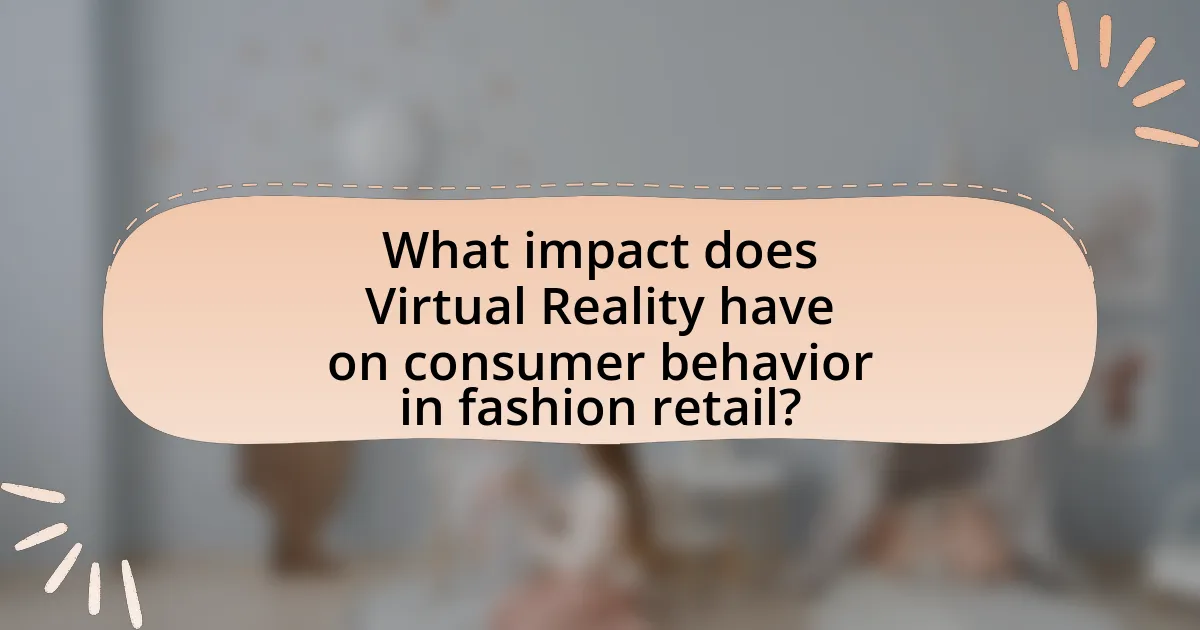
What impact does Virtual Reality have on consumer behavior in fashion retail?
Virtual Reality significantly enhances consumer behavior in fashion retail by providing immersive shopping experiences that increase engagement and satisfaction. This technology allows consumers to virtually try on clothing and accessories, leading to higher purchase intentions and reduced return rates. A study by PwC found that 78% of consumers expressed a preference for shopping in VR environments due to the interactive nature and the ability to visualize products more effectively. Additionally, VR experiences can create emotional connections with brands, fostering loyalty and repeat purchases.
How does Virtual Reality influence purchasing decisions?
Virtual Reality (VR) significantly influences purchasing decisions by enhancing consumer engagement and providing immersive experiences that facilitate product evaluation. Research indicates that VR can increase the likelihood of purchase by up to 30% as it allows customers to visualize products in a realistic setting, thereby reducing uncertainty. For instance, a study by PwC found that 78% of consumers reported a preference for shopping in VR environments due to the interactive nature and the ability to try on clothing virtually. This immersive experience not only boosts confidence in purchasing decisions but also fosters emotional connections with brands, ultimately leading to higher conversion rates.
What role does Virtual Reality play in reducing return rates for fashion items?
Virtual Reality (VR) significantly reduces return rates for fashion items by allowing customers to virtually try on clothing before making a purchase. This immersive experience enhances the decision-making process, as studies indicate that customers who use VR are 30% less likely to return items compared to those who shop without it. By providing a realistic simulation of how garments fit and look, VR helps consumers make more informed choices, thereby decreasing the likelihood of dissatisfaction and subsequent returns.
How does Virtual Reality affect brand loyalty among consumers?
Virtual Reality (VR) enhances brand loyalty among consumers by creating immersive and engaging experiences that foster emotional connections. These experiences allow consumers to interact with products in a virtual environment, leading to increased satisfaction and a stronger attachment to the brand. Research indicates that brands utilizing VR can see a 30% increase in customer retention rates, as immersive experiences lead to higher levels of engagement and positive brand perception. This connection is further supported by a study from the Journal of Business Research, which found that consumers who experienced VR marketing reported a 20% higher likelihood of recommending the brand to others.
What demographic trends are associated with Virtual Reality in fashion retail?
Demographic trends associated with Virtual Reality (VR) in fashion retail indicate a significant engagement among younger consumers, particularly Millennials and Generation Z. These demographics are more likely to adopt new technologies, with studies showing that 60% of Gen Z shoppers express interest in using VR for shopping experiences. Additionally, urban populations with higher disposable incomes are increasingly utilizing VR to enhance their shopping experience, as they seek innovative ways to interact with brands. This trend is supported by market research indicating that 70% of consumers aged 18-34 are open to using VR for virtual try-ons and immersive shopping environments, highlighting a shift towards tech-savvy consumer behavior in fashion retail.
Which age groups are most likely to engage with Virtual Reality shopping experiences?
Individuals aged 18 to 34 are most likely to engage with Virtual Reality shopping experiences. This age group, often referred to as Millennials and Gen Z, demonstrates a higher affinity for technology and immersive experiences, making them more receptive to innovations like VR in retail. According to a study by PwC, 79% of consumers in this demographic expressed interest in using VR for shopping, highlighting their willingness to adopt new technologies for enhanced shopping experiences.
How does consumer familiarity with technology impact Virtual Reality adoption in fashion retail?
Consumer familiarity with technology significantly enhances Virtual Reality (VR) adoption in fashion retail. When consumers are comfortable with technology, they are more likely to engage with VR experiences, leading to increased acceptance and usage. Research indicates that 70% of consumers who frequently use technology are open to trying VR in shopping environments, as they perceive it as an innovative and immersive way to explore products. This familiarity reduces the perceived barriers to entry, such as usability concerns and skepticism about the technology’s effectiveness, thereby facilitating a smoother integration of VR into the retail experience.
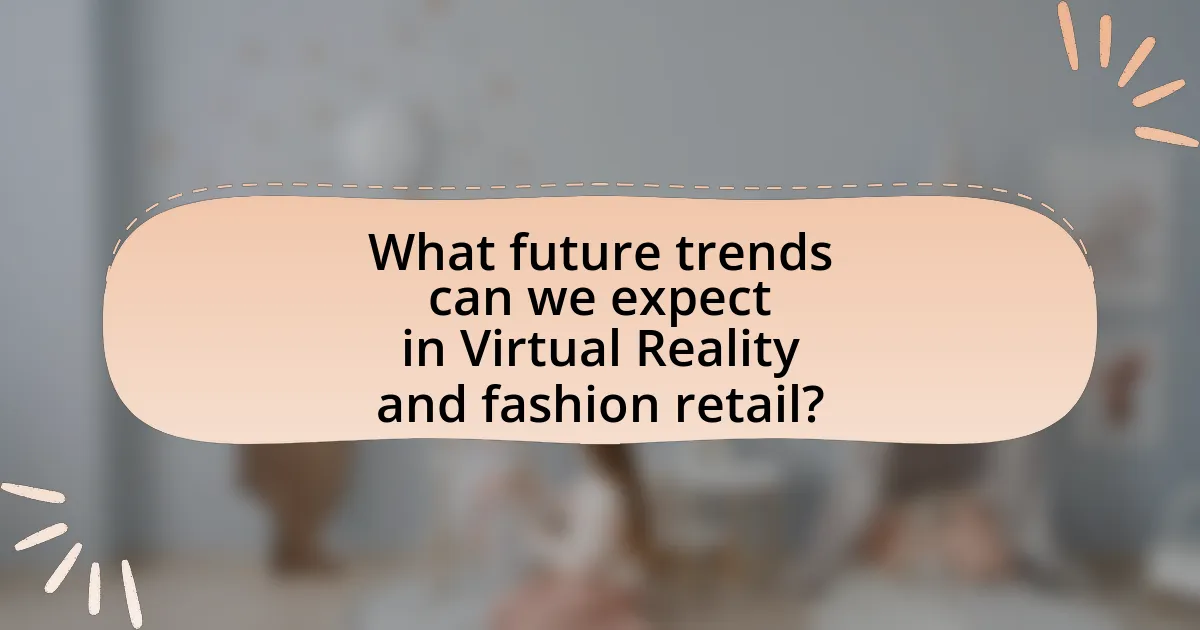
What future trends can we expect in Virtual Reality and fashion retail?
Future trends in Virtual Reality (VR) and fashion retail include enhanced immersive shopping experiences, personalized virtual try-ons, and integration of social shopping features. Enhanced immersive shopping experiences will allow consumers to explore virtual stores that replicate physical environments, providing a more engaging way to shop. Personalized virtual try-ons will leverage advanced body scanning and AI technology to create accurate avatars, enabling customers to visualize how clothing fits and looks on them before making a purchase. Integration of social shopping features will facilitate shared experiences, allowing users to shop together in virtual spaces, which can increase engagement and drive sales. These trends are supported by the growing investment in VR technology by major fashion brands, indicating a shift towards more interactive and consumer-centric retail strategies.
How will advancements in technology shape the future of Virtual Reality in fashion retail?
Advancements in technology will significantly enhance the future of Virtual Reality (VR) in fashion retail by enabling more immersive and personalized shopping experiences. Technologies such as artificial intelligence, machine learning, and improved graphics will allow retailers to create highly realistic virtual environments where customers can try on clothes and accessories in real-time. For instance, a study by the National Retail Federation indicates that 61% of consumers prefer retailers that offer VR experiences, showcasing the demand for such innovations. Additionally, the integration of augmented reality with VR can provide customers with tailored recommendations based on their preferences and body types, further driving engagement and sales.
What innovations are on the horizon for Virtual Reality experiences in fashion?
Innovations on the horizon for Virtual Reality experiences in fashion include enhanced virtual try-on technologies, immersive fashion shows, and personalized shopping experiences. Enhanced virtual try-on technologies utilize advanced algorithms and augmented reality to allow consumers to visualize how clothing fits and looks on them in real-time, significantly improving online shopping experiences. Immersive fashion shows leverage VR to create interactive environments where users can experience runway shows from various angles, making them feel part of the event. Personalized shopping experiences are being developed through AI integration, which tailors recommendations based on user preferences and past behaviors, creating a more engaging and customized shopping journey. These innovations are supported by advancements in VR hardware and software, which are becoming more accessible and affordable, thus driving adoption in the fashion industry.
How might consumer expectations evolve with the growth of Virtual Reality in fashion retail?
Consumer expectations in fashion retail are likely to evolve towards a demand for immersive and personalized shopping experiences as Virtual Reality (VR) technology advances. As VR becomes more integrated into retail, consumers will expect to virtually try on clothing, visualize products in their own environments, and receive tailored recommendations based on their preferences. This shift is supported by a study from the International Journal of Retail & Distribution Management, which found that 61% of consumers are more likely to shop at retailers that offer VR experiences. Additionally, as VR technology improves, consumers will anticipate higher levels of interactivity and engagement, leading to a more dynamic and satisfying shopping journey.
What practical tips can retailers implement to enhance their Virtual Reality offerings?
Retailers can enhance their Virtual Reality offerings by integrating interactive features that allow customers to customize products in real-time. This approach not only engages users but also increases the likelihood of purchase, as studies show that interactive experiences can boost conversion rates by up to 30%. Additionally, retailers should ensure high-quality graphics and seamless navigation to create an immersive experience, as 70% of consumers report that visual appeal significantly influences their shopping decisions. Implementing social sharing options within the VR experience can also enhance customer engagement, as users are more likely to share their experiences on social media, driving organic traffic and brand awareness.
How can retailers create immersive Virtual Reality experiences that resonate with consumers?
Retailers can create immersive Virtual Reality experiences that resonate with consumers by integrating interactive storytelling, personalized content, and realistic simulations of products. Interactive storytelling engages consumers emotionally, allowing them to connect with the brand narrative, while personalized content enhances user experience by tailoring the VR environment to individual preferences. Realistic simulations, such as virtual try-ons or 3D product displays, provide consumers with a tangible sense of the product, increasing their confidence in purchasing decisions. According to a study by PwC, 78% of consumers expressed a preference for immersive experiences that allow them to visualize products in a realistic context, demonstrating the effectiveness of these strategies in enhancing consumer engagement and satisfaction.
What common pitfalls should retailers avoid when integrating Virtual Reality into their business model?
Retailers should avoid several common pitfalls when integrating Virtual Reality into their business model, including underestimating the importance of user experience, neglecting to provide adequate training for staff, and failing to align VR initiatives with overall business goals. A poor user experience can lead to customer frustration and disengagement, as evidenced by a study from PwC which found that 70% of consumers prefer immersive experiences that are easy to navigate. Additionally, without proper staff training, employees may struggle to assist customers effectively, diminishing the potential benefits of VR technology. Lastly, aligning VR projects with business objectives is crucial; a report from McKinsey highlights that 60% of companies that fail to integrate new technologies with their strategic vision do not achieve desired outcomes.
